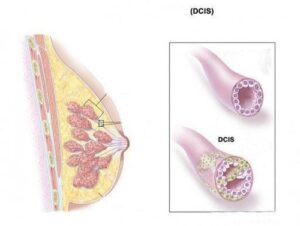Breast cancer is one of the most serious diseases affecting women worldwide. However, if detected early, especially at Stage 0, the chances of successful treatment and survival prognosis are very high. Stage 0 breast cancer, also known as ductal carcinoma in situ (DCIS), is a pre-cancerous or non-invasive cancer stage where abnormal cells appear in the milk ducts but have not spread to surrounding tissues.
1. What is Stage 0 Breast Cancer?
1.1. Definition and Characteristics
Stage 0 breast cancer (DCIS) occurs when abnormal cells appear in the milk ducts but have not invaded surrounding breast tissues. This is an early stage when cancer has not yet metastasized.
-
Non-invasive: Cancer cells remain confined within the duct lining and have not broken through the duct walls.
-
High treatment success rate: When detected and treated early, the five-year survival rate is nearly 100%.
-
Potential progression to invasive cancer: Without treatment, about 20-30% of DCIS cases may develop into invasive breast cancer.
1.2. Is Stage 0 Breast Cancer Considered True Cancer?
There is ongoing debate in the medical community about whether DCIS should be classified as actual cancer or merely a pre-cancerous condition. Some viewpoints include:
-
DCIS is early-stage cancer because it exhibits abnormal cellular characteristics similar to invasive cancer.
-
DCIS is a pre-cancerous condition as not all cases progress to dangerous cancer.
Regardless, DCIS diagnosis requires close monitoring to prevent progression.
2. Types of Stage 0 Breast Cancer
There are two main types of Stage 0 breast cancer:
2.1. Ductal Carcinoma In Situ (DCIS)
-
Accounts for the majority of Stage 0 breast cancer cases.
-
Abnormal cells are confined to the milk ducts and have not spread.
-
Classification by grade:
-
Low-grade DCIS: Slow-growing cells with a low risk of invasion.
-
Intermediate-grade DCIS: Moderate risk.
-
High-grade DCIS: Highly abnormal cells with a high risk of progressing to invasive cancer.
-

2.2. Non-invasive Paget’s Disease of the Nipple
-
Rare, accounting for 1-3% of breast cancer cases.
-
Occurs in the nipple and areola, causing symptoms such as:
-
Red, scaly skin on the nipple.
-
Itching, burning sensation.
-
Nipple discharge, sometimes with blood.
-
-
Often associated with DCIS or invasive breast cancer.
3. Symptoms and Diagnosis of Stage 0 Breast Cancer
3.1. Symptoms
Most DCIS cases do not present clear symptoms and are usually detected through breast cancer screening. Some possible signs include:
-
A small lump in the breast (rare).
-
Nipple discharge (sometimes bloody).
-
Skin changes in the nipple area (in Paget’s disease).
3.2. Diagnosis
Diagnostic methods for DCIS include:
-
Mammography:
-
Detects microcalcifications, an early sign of DCIS.
-
-
Breast Ultrasound:
-
Helps assess abnormal structures.
-
-
-
Core needle biopsy: Extracts tissue samples for testing.
-
Surgical biopsy: Used when malignancy is strongly suspected.
-
-
Hormone Receptor Testing (ER/PR):
-
Determines if cancer cells depend on estrogen, aiding in treatment selection.
-
4. Treatment for Stage 0 Breast Cancer
4.1. Main Treatment Methods
Surgery
-
Lumpectomy (Breast-Conserving Surgery):
-
Removes the tumor and a margin of healthy tissue.
-
Often combined with radiation therapy to lower recurrence risk.
-
-
Mastectomy (Total Breast Removal):
-
Applied if DCIS is widespread or if the patient has a high-risk profile.
-
Breast reconstruction can be performed immediately after surgery.
-
Radiation Therapy
-
Reduces recurrence risk by 50-60% after breast-conserving surgery.
-
Typically lasts 5-6 weeks.
Hormone Therapy (for ER-positive cases)
-
Tamoxifen (for premenopausal women).
-
Aromatase inhibitors (for postmenopausal women).
4.2. Immediate Treatment or Active Surveillance?
-
Immediate treatment: Reduces the risk of progression to invasive cancer.
-
Active surveillance:
-
Suitable for low-grade DCIS with minimal risk.
-
Regular monitoring via mammograms.
-
Controversial: Studies suggest 30% of DCIS cases may progress if left untreated.
-
5. Advice for Stage 0 Breast Cancer Patients
-
Regular Screening: Women over 40 should have annual mammograms.
-
Maintain a Healthy Lifestyle:
-
Eat plenty of vegetables and reduce fat intake.
-
Exercise regularly.
-
Limit alcohol and avoid smoking.
-
-
Consult Your Doctor: Discuss treatment options to determine the most suitable approach.
Conclusion
Stage 0 breast cancer has an excellent prognosis if detected early. Regular screening and timely treatment help prevent progression to dangerous invasive cancer. If diagnosed with DCIS, consult your doctor for the best treatment decisions.
Early Detection – Effective Treatment – Healthy Life!

